For the 2025 school year, there are 2 public elementary schools serving 1,113 students in Edison Elementary School District. This district's average elementary testing ranking is 2/10, which is in the bottom 50% of public elementary schools in California.
Public Elementary Schools in Edison Elementary School District have an average math proficiency score of 18% (versus the California public elementary school average of 35%), and reading proficiency score of 26% (versus the 45% statewide average).
Minority enrollment is 93% of the student body (majority Hispanic), which is more than the California public elementary school average of 79% (majority Hispanic).
Overview
This School District
This State (CA)
# Schools
2 Schools
7,700 Schools
# Students
1,113 Students
3,822,920 Students
# Teachers
56 Teachers
174,006 Teachers
Student : Teacher Ratio
20:1
20:1
District Rank
Edison Elementary School District, which is ranked #1553 of all 1,925 school districts in California (based off of combined math and reading proficiency testing data) for the 2021-2022 school year.
Overall District Rank
#1551 out of 1941 school districts
(Bottom 50%)
(Bottom 50%)
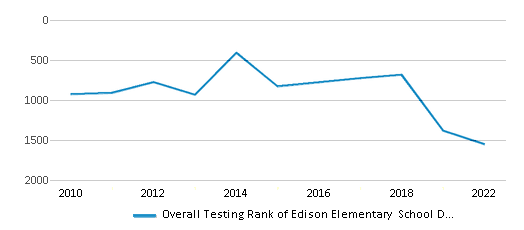
Math Test Scores (% Proficient)
18%
33%

Reading/Language Arts Test Scores (% Proficient)
25%
47%
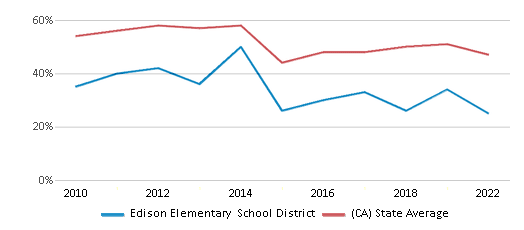
Science Test Scores (% Proficient)
18%
29%
Students by Ethnicity:
Diversity Score
0.24
0.64
# American Indian Students
8 Students
16,785 Students
% American Indian Students
1%
1%
# Asian Students
1 Student
454,357 Students
% Asian Students
n/a
12%
# Hispanic Students
967 Students
2,114,366 Students
% Hispanic Students
87%
55%
# Black Students
17 Students
189,461 Students
% Black Students
1%
5%
# White Students
80 Students
787,389 Students
% White Students
7%
21%
# Hawaiian Students
n/a
15,077 Students
% Hawaiian Students
n/a
n/a
# Two or more races Students
40 Students
240,557 Students
% of Two or more races Students
4%
6%
Students by Grade:
# Students in PK Grade:
-
83
# Students in K Grade:
156
519,574
# Students in 1st Grade:
111
396,601
# Students in 2nd Grade:
139
414,466
# Students in 3rd Grade:
120
416,628
# Students in 4th Grade:
128
426,360
# Students in 5th Grade:
106
430,582
# Students in 6th Grade:
122
432,936
# Students in 7th Grade:
123
312,207
# Students in 8th Grade:
108
312,649
# Students in 9th Grade:
-
44,929
# Students in 10th Grade:
-
37,487
# Students in 11th Grade:
-
37,249
# Students in 12th Grade:
-
41,169
# Ungraded Students:
-
-
District Revenue and Spending
The revenue/student of $19,714 in this school district is less than the state median of $19,974. The school district revenue/student has declined by 9% over four school years.
The school district's spending/student of $16,367 is less than the state median of $18,396. The school district spending/student has declined by 9% over four school years.
Total Revenue
$22 MM
$116,387 MM
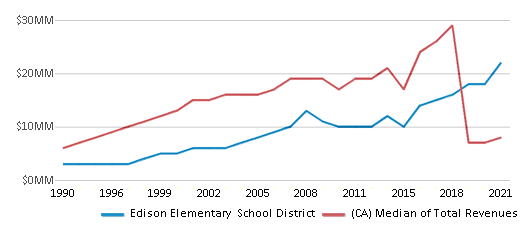
Spending
$18 MM
$107,188 MM
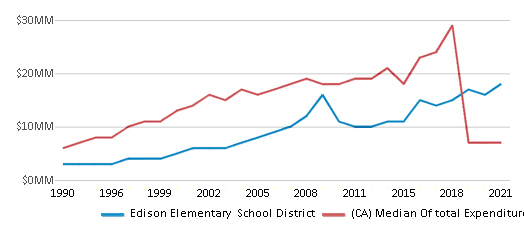
Revenue / Student
$19,714
$19,974
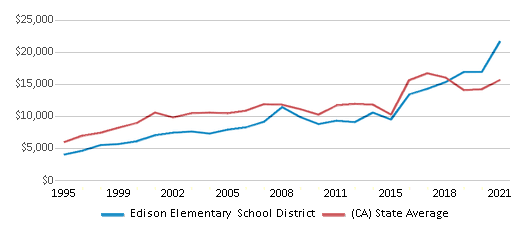
Spending / Student
$16,367
$18,396
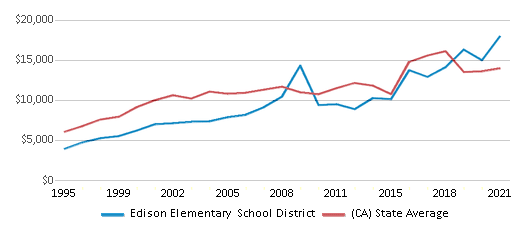
Best Edison Elementary School District Public Elementary Schools (2025)
School
(Math and Reading Proficiency)
(Math and Reading Proficiency)
Location
Grades
Students
Rank: #11.
Orangewood Elementary School
(Math: 27% | Reading: 27%)
Rank:
Rank:
4/
Bottom 50%10
9600 Eucalyptus Dr.
Bakersfield, CA 93306
(661) 366-8440
Bakersfield, CA 93306
(661) 366-8440
Grades: K-4
| 654 students
Rank: #22.
Edison Middle School
(Math: 13% | Reading: 25%)
Rank:
Rank:
2/
Bottom 50%10
721 South Edison Rd.
Bakersfield, CA 93307
(661) 366-8216
Bakersfield, CA 93307
(661) 366-8216
Grades: 5-8
| 459 students
Recent Articles

Year-Round Or Traditional Schedule?
Which is more appropriate for your child? A year-round attendance schedule or traditional schedule? We look at the pros and cons.

Why You Should Encourage Your Child to Join a Sports Team
Participating in team sports has a great many benefits for children, there is no doubt. In this article you will learn what those benefits are.

White Students are Now the Minority in U.S. 九游体育s
Increasing birth rates among immigrant families from Asia and Central and South America, combined with lower birth rates among white families, means that for the first time in history, public school students in the United States are majority-minority. This shift in demographics poses difficulties for schools as they work to accommodate children of varying language abilities and socio-economic backgrounds.





